In addition to producing the Oscars, I’ve had a very busy fall working with many wonderful actors.

Mike Epps and I on the set of UNCLE BUCK, his new show on ABC. Mike posted this picture with the caption “Reggie Hudlin and I burnin’ bridges!”, which was a reference to the script. We had a great time together on set.
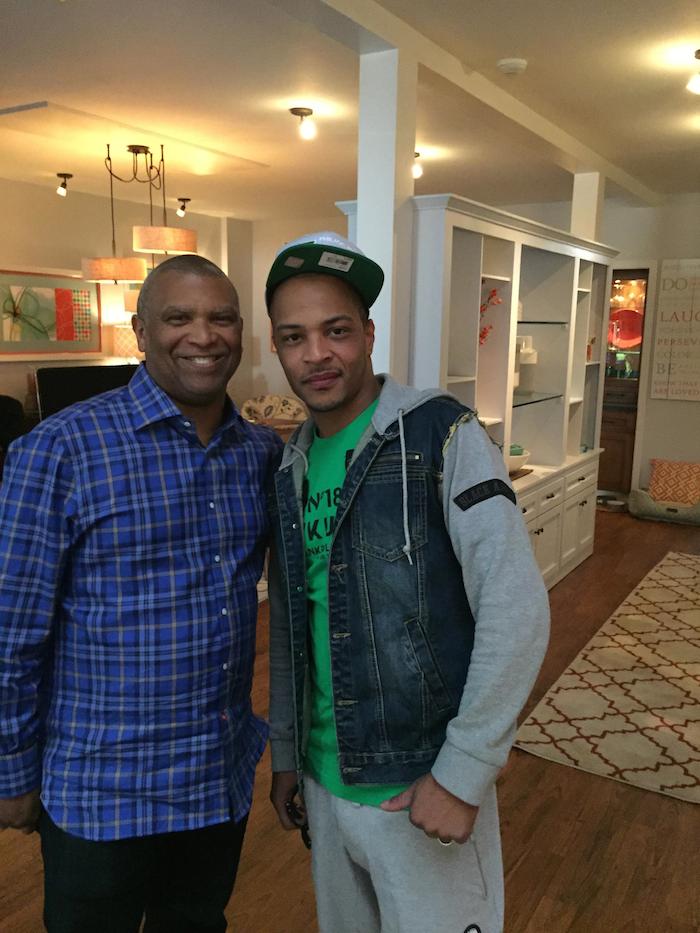
When you have a star like Mike Epps on set, other celebrities drop by, like TI. Humble, charming, funny and every inch a star. I can’t wait to work with him.

Eva Longoria invited me to direct an episode of TELENOVELA, a funny new series on NBC. Don’t let the beauty fool you – Eva is a dynamo! She’s producing the series, very politically active and very charitable. She’s also devoted to her family – we both have mothers who are mental health experts. Love her personality and her politics – we both bonded over black and brown unity.
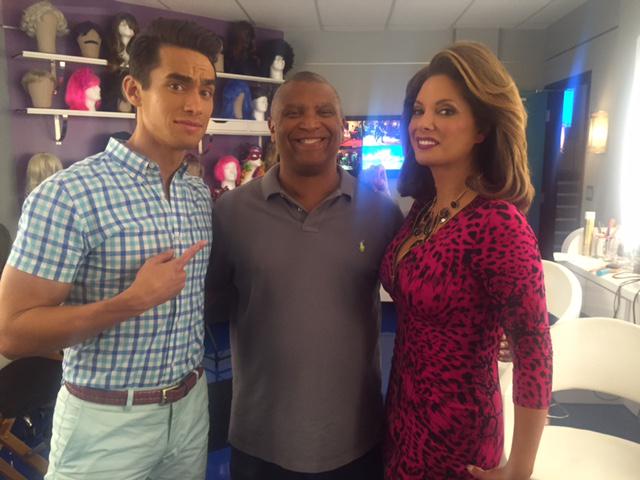
Me with Jose Moreno Brooks and Alex Meneses, two of the hilarious stars of TELENOVELA.
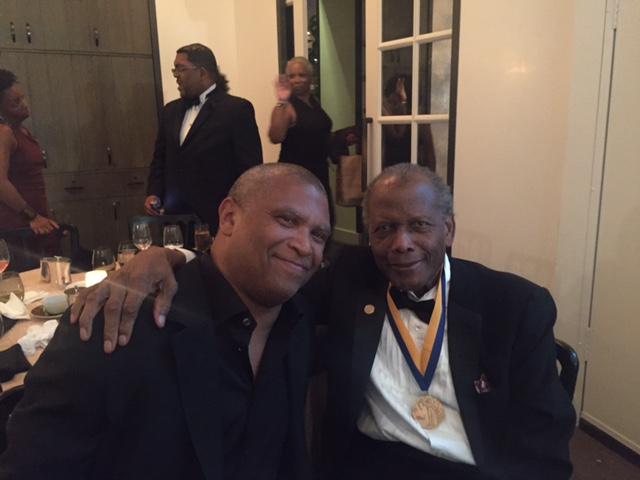
I stopped by to pay homage to GOAT Sidney Poitier who received the NAACP’s highest honor, the Springarn Award. I kept it quick and thanked him for directing and starring in BUCK AND THE PREACHER, which I saw many times at the Loew’s State Theater in downtown St. Louis.
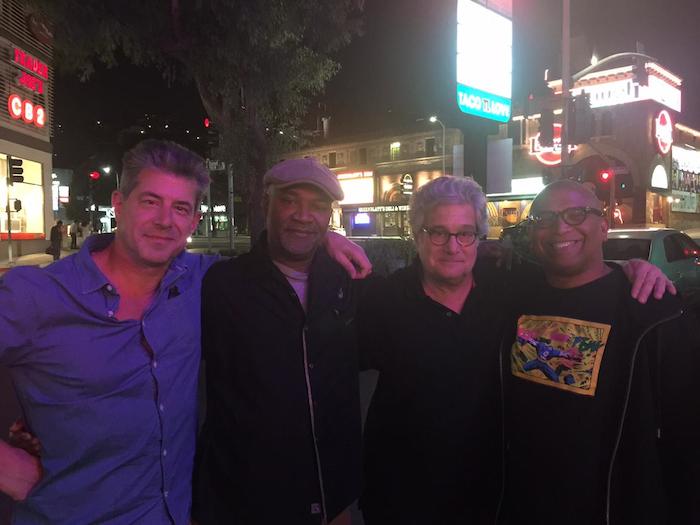
Writer/director Nelson George was in town to support his great new film A BALLERINA’S TALE starring Misty Copeland, which was a great reason for old friends to gather. From left to right is Brian Siberell, Nelson’s agent at CAA; Nelson George; legendary producer Sean Daniels and myself.
Comment
+ Permalink
My kids keep asking me to make a movie they can see… so here’s one!
Cartoon Brew, by Scott Thill | 11/09/2015
An homage to Blazing Saddles, Mel Brooks’ 1974 western spoof, Blazing Samurai is a global animated affair — with a newly announced all-star cast.
Arriving stateside August 4, 2017, from AMC Entertainment and Regal Entertainment’s Open Road Films, Blazing Samurai stars Michael Cera, Samuel L. Jackson, Ricky Gervais, George Takei, Gabriel Iglesias, Aasif Mandvi, Djimon Hounsou, Michelle Yeoh, Sandra Tsing Loh, Mel B., Heavenly Joy Jerkins, and Mel Brooks himself as a madcap array of cats and dogs comedically battling for samurai supremacy not in the Wild West but the faraway Japanese East.
Co-directed by Alvin and the Chipmunks and Garfield animation supervisor Chris Bailey and veteran Disney animator Mark Koetsier, Blazing Samurai also features art direction from New Mr. Peabody & Sherman Show and Steven Universe’s Kevin Dart. Toronto, Canada-based CG animation and visual effects shop Arc Productions (Gnomeo & Juliet) is the lead animation house.
As Cartoon Brew reported earlier this year, Blazing Samurai is the first feature film produced through former Sony Pictures Vice Chairman Yair Landau’s Mass Animation, which originally launched as a Facebook application to crowdsource and produce global animation, including Live Music, which Mass Animation bills as the “first ever theatrically released crowdsourced animated film.” Landau is producing Blazing Samurai with The Lion King director Rob Minkoff and Mass Animation’s Susan Purcell.
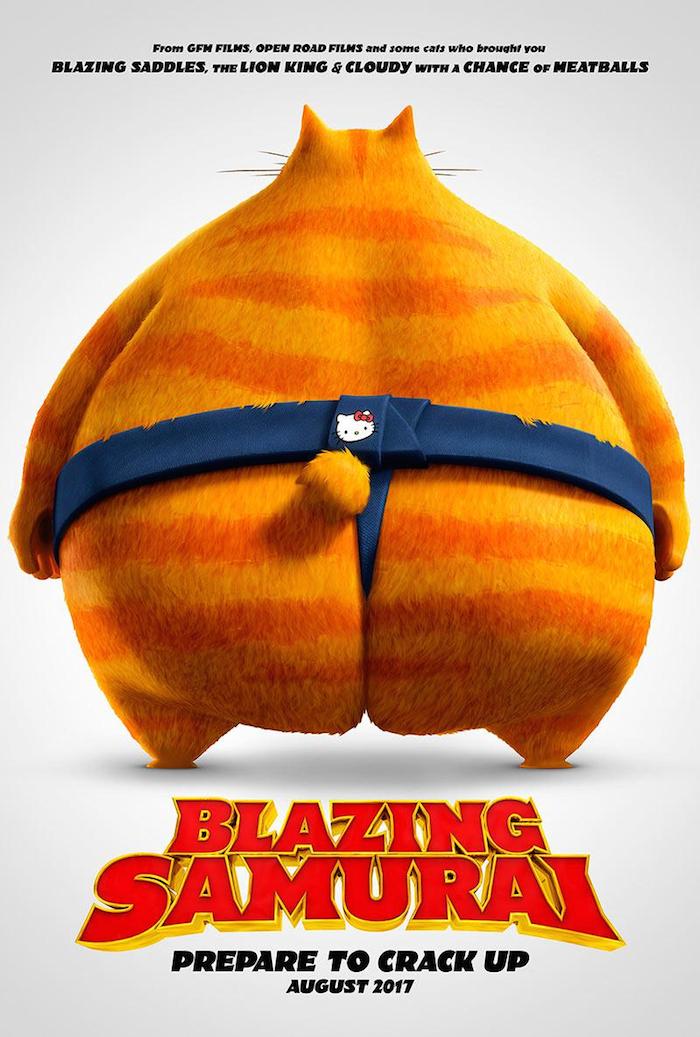
But the film’s international partnerships extend further. Blazing Samurai is co-produced with Huayi Brothers Media Corporation, one of China’s largest film and television studios, as well as Minkoff’s multi-platform production company Flying Tigers Entertainment and London-based GFM Films. Mel Brooks is executive producing alongside The Boondocks’ Reginald Hudlin and Pietro Ventani, from a screenplay by Ed Stone and Nate Hopper.
Hewing lightly to not just Blazing Saddles but also Kung Fu Panda’s lovable loser storylines (and race jokes), Blazing Samurai stars Cera as an upstart dog named Hank who enlists the mentorship of Jackson’s past-it cat warrior Jimbo to transform himself into a samurai to save the crappy town of Kakamucho (get it?) from villainous felines like Gervais’ power-mad Ika Chu.
Much like in Blazing Saddles, Brooks stars as a bumbling but benevolent leader, this time named Shogun. “There is no business like Shogun business,” Brooks said in a press release. “What is wonderful about the film is that it is going to have great appeal not only for kids but their parents too. It’s funny and smart.”
Rounding out Blazing Samurai’s substantial cast, Takei voices the enforcer, Ohga; Hounsou voices the sweet giant, Sumo; Mandvi and Iglesias star as Kakamucho towncats, Ichiro and Chuck; acclaimed author Tsing Loh voices the crotchety “grand dame,” Little Mama; and Chinese cinema’s superstar and stuntwoman Yeoh (Crouching Tiger, Hidden Dragon) voices Yuki, protective mother of the five-year-old Jerkins’ warrior kitten, Emiko.
Handling international sales, GFM Films hosted a presentation of Blazing Samurai’s early animation and visual development last week at Santa Monica, California’s American Film Market. Open Road Films acquired U.S. distribution rights earlier this year, while Landau’s ex-studio Sony Pictures recently picked up several global territories worldwide. Huayi Brothers is distributing Blazing Samurai in China.
Comment
+ Permalink

Reginald Hudlin, David Hill
The Hollywood Reporter, by Gregg Kilday, 10/21/2015
Producers Reginald Hudlin and David Hill predict: “He’s going to hone every word, every phrase, every sentence.”
Although Reginald Hudlin and David Hill, who are producing the 88th Oscars, originally talked of hiring two hosts to front the broadcast, the producers said they opted for a solo host once they secured Chris Rock — with Hill joking, “We decided on Chris and Rock.”
Downplaying reports that other co-hosts like Amy Schumer were under consideration, Hill said, “It became apparent that Chris by himself was the way to go. If you tried to pair him with someone, it wouldn’t have the same comedic impact of him working by himself. So that’s where we ended up.” Rewatching Rock’s performance at the 77th Oscars convinced them that he deserved a return engagement, Hill explained: “He had so many on-the-money observations about the business, delivered in such an enlightened and entertaining way.”
The fact that Hudlin and Rock have worked together — Hudlin directed Rock in 1992’s Boomerang and also helmed the pilot for the 2005 TV series Everybody Hates Chris that Rock co-created — was a factor in convincing the performer to return to the Oscar stage, where he hosted the show for the first time in 2005, they said. “It was lucky because of Reggie’s relationship with Chris — there’s a level of trust between the two of them,” Hill commented.
“We’re friends,” Hudlin added. “I know his mother, he knows my mother. We’re always looking for opportunities to work together, most recently at the 2014 Governors Awards, where he was part of the tribute to Harry Belafonte and did a spectacular job.” In fact, the two producers ironed out final details about the gig with Rock over a dinner at Hudlin’s house Monday night.
Rock, who Hudlin described as a “big-picture thinker,” is expected to take a very hands-on role in helping shape the show, working as a producer as well as host. “The key thing,” said Hill, “is that he’s coming to the show, not simply as a performer, but as a producer as well. He’ll know every aspect of the show as we’re planning it, step by step.”
Added Hudlin, “He’s one of the best hosts we could get, one of the guys who is absolutely hilariously funny and who has a brilliant and intelligent sense of humor. He’s done pretty much every job in the business — as a performer, as a comedian, as a director and producer and writer in film and television and documentaries. Chris attracts incredible talent, the number of people who want to write for him, who want to perform with him. There’s already been an incredible response of A-level talent in every category who want to work with Chris.”
Testified Hill, “He’s the ultimate professional. He prepares before he does a gig like this like he’s writing a Ph.D thesis. He’s going to hone every word, every phrase, every sentence.”
The 88th Oscars will be held Feb. 28, broadcast live by ABC from the Dolby Theatre in Hollywood.
Comment
+ Permalink
New York Times, By Michael Cieply, October 21, 2015

Chris Rock during the Hollywood Film Awards in 2014. Credit Danny Moloshok/Reuters
LOS ANGELES — One problem solved for next year’s Oscar broadcast: Chris Rock, a proven audience draw, will return to host the Academy Awards ceremony, set for Feb. 28.
When last led by Mr. Rock, a raucous comic who has also directed films like “Top Five” (2014), the Oscars drew about 42.2 million viewers in the United States, far outstripping almost all recent broadcasts. That performance was in 2005, when “Million Dollar Baby” was named best picture.
In February, the Oscars, with Neil Patrick Harris as host and “Birdman” the best picture winner, slipped to about 37.3 million viewers, down from a recent peak of 43.7 million viewers in 2014, when Ellen DeGeneres was the host and “12 Years a Slave” took top honors.
In announcing Mr. Rock’s return, Reginald Hudlin, who is producing the ceremony with David Hill, said: “Comedian, actor, writer, producer, director, documentarian — he’s done it all.”
Mr. Rock’s return follows a year in which the Academy of Motion Picture Arts and Sciences, which hands out the Oscars, was widely criticized for overlooking black acting nominees. Mr. Rock’s presence may bolster the show among African-American viewers, who historically have watched the broadcast in large numbers, significantly raising overall ratings, when the black presence is strong among nominees and performers on the stage.
Whether black actors will fare better in this year’s awards race is far from clear, as handicappers have again pointed toward largely white favorites in most categories. One prominent Oscar watcher, the journalist Anne Thompson, this week listed only one black actor — Idris Elba, for his performance in “Beasts of No Nation” — among the apparent front-runners for the 20 acting nominations in four categories.
In 2005, when Jamie Foxx was named best actor for “Ray” and Morgan Freeman won for best supporting actor in “Million Dollar Baby,” Mr. Rock nonetheless tweaked the Academy for its whiteness. During the broadcast, he introduced two burly black men as the supposed representatives of the accounting firm that tabulates the Oscar votes, and showed a taped segment in which he interviewed mostly black moviegoers, asking if they had seen the best picture nominees. None had, but the interviewees claimed to have seen “White Chicks,” starring two of the Wayans brothers.
That sort of humor — biting but self-aware — might help the Academy recover from last year’s dip, when Mr. Harris, normally an adept awards host, was caught up in song, dance and a perhaps misguided stunt that found him onstage in his briefs, mimicking a “Birdman” scene.
Mr. Hudlin and Mr. Hill in early September agreed to produce what will be the 88th Oscar ceremony, after a search that included several possible producers or producing teams to replace Craig Zadan and Neil Meron, who had overseen the previous three shows.
Mr. Hudlin, a filmmaker and executive with wide experience in movies and television, had earlier produced the Academy’s Governors Awards, a separate ceremony that is not televised. Mr. Hill, a television producer and executive who has worked at Fox and elsewhere, has a substantial history in producing sports and other live television events.
“We were both in violent agreement,” Mr. Hudlin said of an early meeting in which he and Mr. Hill first discussed the possibility of Mr. Rock’s returning as host.
Mr. Hill said Mr. Rock’s earlier performance hit precisely the note they seek from the next show. “It wasn’t about him,” Mr. Hill said. “It was all about the industry, all about his peers, all about the movies.”
Mr. Rock recently directed an HBO comedy special, “Amy Schumer: Live at the Apollo.” Last year, he directed and starred in the film “Top Five,” about the life and times of a New York City comic and film star being interviewed by a reporter for The New York Times.
While Mr. Rock generally stayed in bounds during his previous appearance as Oscar host — some Academy members privately groused about his jabs at Hollywood — he is known for flirting with danger in his live performances.
In the days after the terror attacks on the World Trade Center, for instance, Mr. Rock showed up in a Los Angeles area comedy club, trying out a comic routine about the attack. Ultimately, he used a somewhat tempered routine at a Carnegie Hall comedy benefit for 9/11 survivors.
At this year’s Governors Awards dinner, set for Nov. 14 in Los Angeles, the Academy is poised to bestow its honorary awards on a lineup that includes Debbie Reynolds, known for classic and somewhat lighthearted entertainment like “Singin’ in the Rain”; Gena Rowlands, who has starred in sophisticated fare like “A Woman Under the Influence”; and Spike Lee, whose bent for sharp-edged social humor and drama in films like “Do the Right Thing” and “Malcolm X” should help set the stage for Mr. Rock.
Comment
+ Permalink









